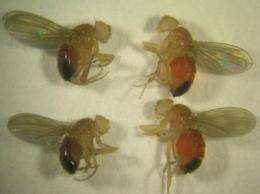Researchers identify genes and brain centers that regulate meal size in flies

Biologists from the California Institute of Technology and Yale University have identified two genes, the leucokinin neuropeptide and the leucokinin receptor, that appear to regulate meal sizes and frequency in fruit flies. Both genes have mammalian counterparts that seem to play a similar role in food intake, indicating that the steps that control meal size and meal frequency are not just behaviorally similar but are controlled by the same genes throughout the animal kingdom.
A paper describing the work will appear in the June 8 issue of the journal Current Biology.
In animals, food intake is regulated to keep body weight constant over a long period of time. Most animals consume food in discrete bouts—that is, in meals. "Identifying the genes and molecules that regulate meal-related parameters is essential for understanding the relationships between body weight and caloric intake," says Bader Al-Anzi, a research scientist at Caltech and the lead author of the Current Biology study.
In hungry animals, meal size and frequency are regulated in three phases. In the first phase, the smell and taste of food initiates feeding. Once a meal has begun, other factors assure that the feeding bout will continue for given period of time (representing the second phase). In the final phase, feeding is terminated—usually when the amount of stomach distension passes a given threshold. The three phases of feeding behavior have been observed in animals ranging from mammals to insects. However, what was unknown was whether similarities in behavior actually reflected an evolutionarily conserved process that employed similar genes and molecules across animal species.
To help answer this question, Al-Anzi and his colleagues developed an assay to examine feeding behavior in the common fruit fly, Drosophila melanogaster. In this assay, genetically normal flies were starved for one day and then transferred into a vial containing sugar meal mixed with red food dye. Invariably, the flies became satiated during their exposure to red food, and their small abdomens turned red.
Next, the researchers performed the same experiment using mutant fly strains. "Our hope," says Al-Anzi, "was that if flies contained mutations in genes involved in meal regulation, those flies would eat excessive amounts of red food, making them visibly bloated with red abdomens."
Two mutant fly strains produced notable results. One strain contained a mutation in the gene encoding the leucokinin neuropeptide (a peptide initially identified for its ability to induce insect gut contraction), and the second strain contained mutated versions of the receptor that binds to leucokinin. In the assay, both types of fly mutants ate to such excess that they became visibly bloated, with their crops—food storage organs—stretched to the limit with red-dyed food.
Surprisingly, Al-Anzi says, "although in the short term these flies tend to overeat, in the long run they consume a similar amount of food as normal flies. This was largely due to the fact that they are compensating for the large increase in meal size by reducing the number of times they eat." Whereas mutant flies consumed four or five large meals in a single day, normal flies ate seven or eight small meals.
In additional experiments, Al-Anzi and his colleagues found that although the leucokinin neuropeptide is found exclusively in the brain, the leucokinin receptor is found in neurons located in both the brain and the foregut—an area of the gut that contains stretch receptors known to be responsible for monitoring meal size in other insects. The researchers also found that introducing a normal copy of the leucokinin neuropeptide or of the leucokinin receptor gene to these neurons in their corresponding mutant flies fully restored normal feeding behavior.
Furthermore, when these same neurons were destroyed in normal, nonmutant flies, the flies began to consume abnormally large meals, just like mutants. "This proves that we identified the right genes responsible for the flies' bingeing as well as the fly brain center that regulates meal size and frequency," Al-Anzi says.
These results suggest that in normal flies, the stretch receptors signal to the brain that it is time to stop eating when the gut becomes full. In flies in which the leucokinin neuropeptide or leucokinin receptors are not functioning properly as result of mutations or the destruction of the brain centers that express the genes, the "time to stop" signal isn't properly relayed, and the flies—unaware that their bellies are full—continue to eat.
Both leucokinin and its receptor are homologous to tachykinins—vertebrate pathway genes known to cause a reduction in food intake when injected into the brain. Indeed, some tachykinin pathway genes are expressed within or close to mammalian brain centers that regulate body weight and food intake, including a region known as the arcuate nucleus. The observation that a fly tachykinin plays a similar role in food-intake regulation indicates an evolutionarily conserved role for this signaling system in controlling food intake.
"Despite our disparate body forms, the functions of many genes are conserved across the animal kingdom—including in the lowly fruit fly," Al-Anzi says. Because of this, he says, "if we know what a given gene does in a fly, it is likely that its counterpart in humans would play a similar role. However," he adds, "I was still surprised that this conservation extends even to behavioral phenomena like meal-size regulation. The fruit fly is a powerful model organism for studying the genetic basis of many biological phenomena, and the evolutionarily conserved role of the leucokinin pathway in meal-size regulation indicates that, when it comes to food intake, we can now further exploit the genetic powers of Drosophila to understand the molecular basis of food intake regulation in humans."
More information: "The Leukokinin Pathway and Its Neurons Regulate Meal Size in Drosophila," Current Biology.
Provided by California Institute of Technology

















